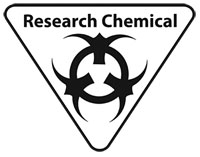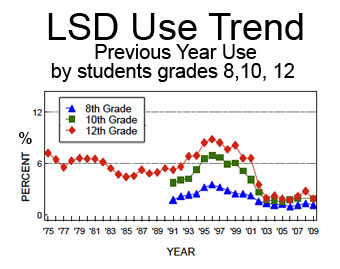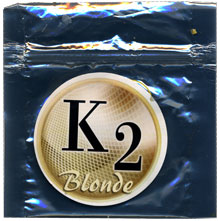
|
Connecting the Microdots
The State of the Stone 2010
Jun 2010
Citation: Erowid F, Erowid E. "Connecting the Microdots: The State of the Stone 2010". Erowid Extracts. Jun 2010;18:12-18.
The following is based on a presentation Earth and Fire gave at the Psychedelic Science in the 21st Century conference in April 2010.
Terence McKenna was an inspired teller of tales and a psychedelic thinker of big thoughts. Even after his death, his stories remain some of the most compelling renditions of what spiritually informed psychedelic seekers may encounter in their travels.
McKenna presented several talks in his career titled "State of the Stone", in which he described current psychedelic culture and the mindset of psychedelic enthusiasts. He occasionally expressed a mistrust of science, of a purely scientific viewpoint, or of the overly self-certain philosophy of science. He commented that human experiences, especially those precipitated by psychedelic drugs, are often measured and dismissed by the scientific industry. In 1995, he said:
As we pass the ten-year anniversary of his death, and with thanks to Terence for reminding us that the universe is far bigger and the human experience far weirder than much scientific inquiry lets on, we're following his lead with a variant of his State of the Stone address.
Now is the history of the future. The actions of recreational psychoactive users today--the conferences they attend, the articles they write, the topics they blog about, the organizations they support, the research they participate in, the products they buy, the psychedelics they use--will be retained in the consciousness of our culture as it looks back on this now.
Since Terence gave his last address, the State of the Stone has morphed to include a resurgence of psychedelic research, court successes of ayahuasca-drinking churches in the United States, the expansion of medical cannabis into the public consciousness, the continued evolution of online communication modalities, the reduced availability of LSD, and an increase in availability of recreationally used pharmaceuticals and new psychoactive "research chemicals".
Just as the drugs available 10 or 100 years ago affect what is thought about psychoactives, how they are discussed, and what is researched in universities, laboratories, and dorm rooms, so too will the psychoactive substances available today affect study and research in the future.
To understand the now of available psychoactives, we look back to the late 1990s through the mid-2000s, to the first big wave of recreational drugs available online.
During this period, there was an expanding and evolving market both for ethnobotanicals and pure, synthesized chemicals. Erowid and others began calling these relatively unknown chemicals "research chemicals" to highlight the risk of ingesting drugs that were not well tested for toxicity in the general population.
This period was characterized by small, independent, commercial labs synthesizing and selling Shulgin creations first publicized in PIHKAL and TIHKAL. Certificates of purity sometimes accompanied the products, along with a fig leaf of pretense that the vendors were selling only for legitimate laboratory research and not for human consumption.
One of the more interesting elements of the businesses selling research chemicals during this period is that there was little to no hint of connection to larger criminal organizations involved with cocaine, methamphetamine, or heroin distribution.
Most of the products sold were non-addictive psychedelic substances that were of interest primarily to psychonauts and curious newbies. The primary exceptions were the GHB family of drugs (GHB, 1,4-B, and GBL), which were just becoming associated with addictive, compulsive behavior (sim-ilar to alcohol in many ways).
One often is left to wonder if senior drug control authorities are aware of just how much their choices dictate which drugs 18- to 22-year-olds are exposed to. Some in the enforcement apparatus must know that when they block access to one drug, demand is then redirected fractally and organically.
The package purports to contain "incense" and includes 13 herbs and spices in its ingredients list. It fails to mention the synthetic cannabinoid(s) deposited on the herbal base.
There have been herbal cannabis replacements available for nearly 40 years and approximately none have induced effects that could be confused with those of cannabis. But quickly after Spice hit the market it began to stand out from previous products because many people described that it had effects very similar to cannabis. From the reports, Spice seemed like it contained cannabis, a cannabis extract, or a synthetic cannabinoid. Taking a method cue from Arthur Heffter, we tried smoking the material ourselves and were quickly convinced that the effects were the result of a cannabinoid, and not simply a synergy of the listed ingredients.
In 2007 we had a sample analyzed via GC/MS, asking the lab to look for THC and other cannabinoids. They were unable to determine the identity of the psychoactive chemicals in the mix, ruling out cannabis or any simple cannabis extract.
Spurred on by media attention, in December 2008 a cannabinoid-specializing lab in Germany finally identified a chemical in Spice called JWH-018, an obscure synthetic cannabinoid receptor agonist.
Soon after, U.S. Customs reported that Spice packages that they had seized contained HU-210, another research cannabinoid. Then, in the January 2009 issue of the Journal of Mass Spectrometry, a second German cannabinoid lab identified a close homolog of CP-47,497, yet another cannabinoid receptor agonist not previously seen on the recreational market. Since then, three additional cannabinoid-like compounds have been identified in samples of Spice: JWH-073, JWH-398, and JWH-250.1
During 2008 and 2009, dozens of knock-off brands also became available. In 2009, the United Kingdom, Germany, and several other European countries moved to ban one or more of the chemicals found in Spice.
K2 is marketed as an "exotic herbal incense containing a combination of rare plants, herbal extracts, and botanical concentrates", sold in dark grey plastic baggies containing 3 grams of plant matter for $20-30 (USD) each. It contains both JWH-018 and JWH-073.2
Whereas the research chemicals of the early 2000s (2C-T-7, 5-MeO-DIPT, etc.) were packaged as pure chemical powders, Spice, K2, and other variations are innocuously packaged as natural herbal blends, in the long tradition of feckless cannabis substitutes. So instead of being sold primarily through chemical vendors, they have ended up in brick-and-mortar headshops and ethnobotanical stores in the U.S., sold by vendors who never would have sold pure 2C-T-7 or the majority of the previous generation of research chemicals.
On February 4, 2010, several weeks before a new law was passed, two vendors in Kansas (Bouncing Bear Botanicals and Sacred Journey) were the target of a joint FDA, Kansas Bureau of Investigation, and local Lawrence, Kansas law enforcement raid. Both of the vendors had been actively involved in lobbying against the new law.
A couple of weeks before the raid, one of the vendors contacted Erowid to ask for help finding experts who might bolster their arguments against banning K2. They later expressed that they felt they were being targeted because of their political activism. Initial charges were dropped, but the prosecutor has suggested that new charges may be brought in the future, and seized property has not been returned.
Several additional states are moving forward with banning the synthetic cannabinoids that previous laws left uncovered.
Even extended, heavy use does not appear to cause brain damage or substantially increased risk of lung cancer or heart disease in healthy users, and it causes only moderate increases in respiratory illnesses. However, it is unknown if the same is true of Spice, K2, or related products.
Cannabis is, however, well known for causing some people to experience paranoid ideation and feelings of anxiety. This triggering of psychotic symptoms is one of the top cannabis-related issues receiving research attention in the last decade. Some novel cannabinoids might not cause paranoia or might be less likely to trigger latent psychoses than cannabis. There is value in exploring THC-like compounds in case they do not produce these negative effects.
Communication technologies are driving the now of psychoactive drugs. The State of the Stone is only what it is because of these digital technologies. Anyone can participate in a specific drug culture, psychedelic subculture, medical monitoring system, or even drug research project. Each can find their own favorite flavor that coincides with their interests.
Take "Ivory Wave" (recently renamed "Vanilla Sky"), with its shiny, corporate, mass-produced packaging. It is sold by the same vendors who sell other recreational psychoactives, although the manufacturer states it is "concentrated bath salts". Groups of anonymous aspiring drug geeks discuss in detail in the hidden corners or very public squares of the Internet what effects they got when they snorted it and what they think its unidentified active chemicals could be.
Do you suppose it is (-)-2-β-carbo-methoxy-3-β-(4-fluorophenyl)tropane (β-CFT, WIN-35,428)? Maybe. Maybe not. Perhaps it's fancy packaging for MDPV. Or maybe it's 4-methylmethcathinone or bk-PMMA, or ephedrine. Or maybe it's really just bath salts that nobody should be putting in their nose. Actually, it's unclear whether it's worse to snort MDPV or bath salts. We might know in a decade or two.
But Spice and Ivory Wave are not the only new products out there: what is in "NRG-1" or "Doves"? A brave explorer could be the first on their block, or in their city, or maybe in their country to try "London Underground Doves" which, based on one anonymous laboratory analysis, purportedly contains both bk-MBDB and mCPP.
People are interested in part because these products are theoretically legal and easily acquired online, but also because they are novel materials and experiences.
A death from the careless use of a research chemical also raises its public profile, and provides fodder for the sensational news stories that will haunt that substance for the foreseeable future.
In addition to dangers possibly inherent to certain substances, problems can arise from misidentification. Two deaths last fall, one in California and another in Denmark, were the result of mislabeling by a vendor. The first indication was a post to an online forum that warned that the vendor selling a batch of 2C-B-fly had died after ingesting some himself. At that time it was not known whether a contaminant in the chemical was responsible, or if the drug had been misidentified.
Erowid worked with customers of the vendor, Team Shulgin, and the excellent Spanish risk reduction and drug testing organization Energy Control to analyze the chemical sold as 2C-B-fly. Energy Control's simple and effective thin-layer chromatography strongly indicated the material was bromo-dragonfly, a result that was later confirmed by both their lab and ours. This packaging error led to two deaths, as people took a dose ten times higher than they should have of a mislabeled and unregulated substance.
For many people, there is a thrill to ingesting a new substance as well as excitement to trying to solve the mystery of its nature. Tasting and comparing unknown substances and collaboratively working to identify them is a modern day version of Amazonian residents tasting the bark of various trees in combination with the leaves of every plant to test their effects.
In the market now, it is difficult to tell good snake oil from bad snake oil, effective from ineffective, or dangerous from well-known. There are dozens of research chemicals currently available online or in head shops. They are sold as "legal highs", and often, whether implicitly or explicitly, positioned as replacements for a particular illegal drug like psilocybin mushrooms or cocaine. Some contain chemicals brand new to the recreational markets, while others are just caffeine.
Along with being sold as party pills and illegal drug stand-ins, some are sold as potpourri, incense, bath salts, plant food or plant growth inhibitors, dewormers, and room deodorizers. There is a swirling blizzard of new products.
From the packaging, one can't even tell the chemical from the herbal, or products of a Chinese factory from those out of a Central American garden. There are all manner of psychoactive plants and herbs now sold in glossy single-serving packages. There are pre-rolled Salvia divinorum and kratom joints, blue lotus tinctures, seeds and pastes and extracts and leaves and roots, all ready for use.
Even the form of the material doesn't aid identification much. There are pills with herbal ingredients and herb mixtures with synthetic ingredients. Annoyingly, there seems to be an inverse relationship between how illegal a product's components are and how much it's marketed like an illegal drug. The pure, psychoactive compounds like 4-methylmethcathinone are sold as plant growth inhibitors, while low-activity herbs are sold to "GET YOU HIGH".
The marketing of untested drugs to the general public is a service we shouldn't need. If cannabis were legal, Spice wouldn't exist. The repercussions of getting caught with a clearly illegal substance can be huge, including the possibility of losing federal financial aid for college. Once a person has made the decision to experiment with psychoactive drugs, a fairly rational evaluation of the risks and benefits will lead some to order Spice or Ivory Wave instead of buying cannabis or alcohol if underage.
One person posting to the popular Bluelight forums told the story of moving to the United Kingdom and choosing to buy grey-market drugs instead of ecstasy or cannabis. They acknowledged that the risks of the use of these research chemicals, these "plant foods", are unknown. But being caught with something that is clearly illegal could endanger their citizenship. Being caught with something of questionable legality likely would not.
Another person commented that finally they could know they were taking a "pure" substance, without acknowledging that the substance lacked essentially any human toxicity testing.
Although the ethnobotanical and research chemical spectrum can seem to be a vulgar, profit-driven marketplace, taking advantage of the inexperienced, it's also the cutting-edge of the science of psychoactive mind expansion. Many scientists working in this field are driven by their own experiences with visionary states.
Bill Richards, one of the key researchers in the Johns Hopkins psilocybin studies, was powerfully influenced in his career path by his own encounter with psilocybin in 1963, when he participated in psychological research in Germany. He first published about his experience pseudonymously in 1968, and then took full ownership in the peer-reviewed literature in 2004.3,4 As he described it:
The 2010s will be to the 2060s what the 1960s are to us today.
The young people going through college and cutting their teeth on widely available research chemicals today are in a different world. Every few months we hear from someone who has just received their PhD in pharmacology, chemistry, neurology, or psychology, wanting to let us know that they have been reading Erowid for years and were inspired in their career choice by their readings. In 40 years, they will be the senior researchers. They will have grown up not only with access to psychedelics, but with access to a dizzying array of psychoactives; extensive information about their effects, chemistry, and culture; and communication systems allowing them to stay connected to others interested in the topic beyond the typical recreational drug-using period of youth. It will be fascinating to see what happens with generations for whom the communications boundaries have all but dissolved. This will certainly have a significant impact on future research.
Further, in the now there are no hard lines between researchers and the subculture. Members of the psychedelic subculture have access to the same scientific understandings about psychedelics that researchers do, such as mechanisms of harms like MDMA neurotoxicity, or spiritual benefits of psilocybin documented by the Griffiths group at Johns Hopkins. The distinction between scientific researchers, pharmaceutical researchers, subculture researchers, and that chemistry geek in the college dorm are more blurry than they have been since before the explosion of psychedelics into the culture, and the backlash against them, in the mid-1960s.
Science can be defined as the collection and evolution of knowledge, rather than as the formal professional enterprise of academic researchers. Arguably, the collective knowledge of the people attending a psychedelic conference in 2010--not the presenters, but the attendees--will historically be judged as the state of the science of psychedelics in 2010.
The proof of this view is that the groundbreaking Johns Hopkins psilocybin research was not new at all. The finding that psilocybin can "occasion mystical experience" is not even remotely new. It hasn't been new in centuries, if one extends one's frame of reference to include other cultures. But even within the context of well-known literature in the English language, it hasn't been real news in 45 years. This fact does not detract from the research, of course, and is something the researchers know very well.
The function of formal, peer-reviewed science often lies not in discovering the new so much as confirming and quantifying what is already known. The work being performed in psychedelic research is groundbreakingly parameterizing, proceduralizing, and documenting known facts. There are many things that people reading this article could agree on about psychedelics that are not yet confirmed data points in the scientific literature, but which will be someday.
What is novel about the now is not any individual new discovery or product. Instead, it is the pattern of a constant stream of new materials, packaging, and grey-marketing methods, allowing the right consumers to know that something is an interesting drug for as long as possible before law enforcement catches up and prohibits it. Of course, this very pattern constitutes danger as well, for it means that substances are often ingested without enough data to make an informed assessment of risk.
What's novel about the current State of the Stone is the combination of these new substances with the ability to communicate about them with an increasingly inclusive "anyone". In the 1960s, new drugs were also becoming available. But in the now, a producer-vendor can, in a one-year period, choose a new drug, conduct testing, mass produce it, market it, advertise it through the subculture, sell it, and ship it to your door anywhere in the world.
We'll leave you with the thought that those of you reading this text will have a powerful impact on how those in the future think about psychedelics and recreational psychoactives. Whatever your opinion of Terence and his stoned rants, the State of the Stone has changed substantially in the decade since his death. This now is a pivotal moment in the understanding of the complex relationship between humans and psychoactive drugs.
Terence McKenna was an inspired teller of tales and a psychedelic thinker of big thoughts. Even after his death, his stories remain some of the most compelling renditions of what spiritually informed psychedelic seekers may encounter in their travels.
McKenna presented several talks in his career titled "State of the Stone", in which he described current psychedelic culture and the mindset of psychedelic enthusiasts. He occasionally expressed a mistrust of science, of a purely scientific viewpoint, or of the overly self-certain philosophy of science. He commented that human experiences, especially those precipitated by psychedelic drugs, are often measured and dismissed by the scientific industry. In 1995, he said:
Defining the state of the now is about acknowledging history, experiencing the present, and envisioning what paths we are taking into the future.
For all of its capacity to razzle-dazzle, Science has some serious drawbacks, some serious limitations that psychedelic experiences make more starkly evident. [...] Science works very differently from ordinary perception. [...] If we have a thousand people who go out on a starry night and see only the ordinary constellations, that is buried. But if one person goes out on a starry night and sees a rectangular black object a city block long with softly glowing yellow lights moving along the horizon, that's big news.We have all experienced the annoyance of reading overly trumpeted findings from scientific publications, knowing that there is a huge likelihood that at least one crucial component of the finding will be later refuted or changed. We must be careful of overweighting any single finding. But we also need to avoid dismissing the unique things that happen in the world.
Science works exactly the opposite. If you want, for example, to carry out a scientific observation, and you measure let's say the electrical charge running through a wire, and you measure it a thousand times, and 999 times it's between 3 and 4 volts, but one time you get a measurement of 1,290 volts, a good scientist discards the aberrant measurement. He says, 'Well that can't be right, that's ridiculous. Get that puppy out of there. Now average the other 999.' A completely different way of doing intellectual business than the way it is done at the edge of human thought, where we seek the curious, the anomalous, the unusual...
As we pass the ten-year anniversary of his death, and with thanks to Terence for reminding us that the universe is far bigger and the human experience far weirder than much scientific inquiry lets on, we're following his lead with a variant of his State of the Stone address.

|
Connecting History to Future
Defining the state of the now is about acknowledging history, experiencing the present, and envisioning what paths we are taking into the future. What are the connecting points between the past, the now, and the future? What are the unique aspects? How is now different? What is the importance of this particular now?Now is the history of the future. The actions of recreational psychoactive users today--the conferences they attend, the articles they write, the topics they blog about, the organizations they support, the research they participate in, the products they buy, the psychedelics they use--will be retained in the consciousness of our culture as it looks back on this now.
Since Terence gave his last address, the State of the Stone has morphed to include a resurgence of psychedelic research, court successes of ayahuasca-drinking churches in the United States, the expansion of medical cannabis into the public consciousness, the continued evolution of online communication modalities, the reduced availability of LSD, and an increase in availability of recreationally used pharmaceuticals and new psychoactive "research chemicals".
1990s-2004
From our vantage point on the visionary sphere, the State of the Stone is tightly tied to what psychoactive substances are currently in use and shaping the psychonautical mind spaces.

|
To understand the now of available psychoactives, we look back to the late 1990s through the mid-2000s, to the first big wave of recreational drugs available online.
During this period, there was an expanding and evolving market both for ethnobotanicals and pure, synthesized chemicals. Erowid and others began calling these relatively unknown chemicals "research chemicals" to highlight the risk of ingesting drugs that were not well tested for toxicity in the general population.
This period was characterized by small, independent, commercial labs synthesizing and selling Shulgin creations first publicized in PIHKAL and TIHKAL. Certificates of purity sometimes accompanied the products, along with a fig leaf of pretense that the vendors were selling only for legitimate laboratory research and not for human consumption.
Operation Web Tryp
In 2004, the U.S. Drug Enforcement Administration cracked down on a handful of the most prominent vendors in the United States, prosecuting two on the basis that their customers had died as a result of ingesting their products. Some customers were persuaded to provide evidence against the vendors. Though several vendors spent time in jail and lost assets, and a few were sentenced to heavy terms, most served no prison time.One of the more interesting elements of the businesses selling research chemicals during this period is that there was little to no hint of connection to larger criminal organizations involved with cocaine, methamphetamine, or heroin distribution.
Most of the products sold were non-addictive psychedelic substances that were of interest primarily to psychonauts and curious newbies. The primary exceptions were the GHB family of drugs (GHB, 1,4-B, and GBL), which were just becoming associated with addictive, compulsive behavior (sim-ilar to alcohol in many ways).
Hibernation
Following Operation Web Tryp, the online deliver-to-your-door recreational drug market went into hibernation for a couple of years. Looking back, it is obvious that the DEA's operation acted as an evolutionary pressure, pushing the entrepreneurs and vendors in new directions.One often is left to wonder if senior drug control authorities are aware of just how much their choices dictate which drugs 18- to 22-year-olds are exposed to. Some in the enforcement apparatus must know that when they block access to one drug, demand is then redirected fractally and organically.
The NOW
Over the last few years, there has been a new wave of synthetic psychoactive drugs produced and sold, including cannabinoids, psychedelics, and stimulants (especially cathinone variants of previously existing drugs). Spice
The developments around packaged smokable products marketed as cannabis replacements are particularly interesting. As described in "Spice and Spin-Offs" (Erowid Extracts #16, June 2009), these products marked a new stage in the evolution of recreational psychoactives. First available in late 2006, "Spice" was notable for its packaging's slick, professional appearance. Three-gram packets have sold online, as well as in European head shops, for $20-50 (USD), a price similar to good quality street cannabis.

|
There have been herbal cannabis replacements available for nearly 40 years and approximately none have induced effects that could be confused with those of cannabis. But quickly after Spice hit the market it began to stand out from previous products because many people described that it had effects very similar to cannabis. From the reports, Spice seemed like it contained cannabis, a cannabis extract, or a synthetic cannabinoid. Taking a method cue from Arthur Heffter, we tried smoking the material ourselves and were quickly convinced that the effects were the result of a cannabinoid, and not simply a synergy of the listed ingredients.
In 2007 we had a sample analyzed via GC/MS, asking the lab to look for THC and other cannabinoids. They were unable to determine the identity of the psychoactive chemicals in the mix, ruling out cannabis or any simple cannabis extract.
Spurred on by media attention, in December 2008 a cannabinoid-specializing lab in Germany finally identified a chemical in Spice called JWH-018, an obscure synthetic cannabinoid receptor agonist.
Soon after, U.S. Customs reported that Spice packages that they had seized contained HU-210, another research cannabinoid. Then, in the January 2009 issue of the Journal of Mass Spectrometry, a second German cannabinoid lab identified a close homolog of CP-47,497, yet another cannabinoid receptor agonist not previously seen on the recreational market. Since then, three additional cannabinoid-like compounds have been identified in samples of Spice: JWH-073, JWH-398, and JWH-250.1

|
K2
Since the beginning of the Spice phenomenon, its distributors chose not to sell it through U.S. vendors, explicitly stating this restriction on the packaging. This limited the product's availability in the United States to those able to find a reseller willing to ignore the restrictions. As a result, the synthetic cannabinoids hadn't made much of an impact in the U.S. until mid-2009, when a new product called "K2" became widely available.K2 is marketed as an "exotic herbal incense containing a combination of rare plants, herbal extracts, and botanical concentrates", sold in dark grey plastic baggies containing 3 grams of plant matter for $20-30 (USD) each. It contains both JWH-018 and JWH-073.2
Whereas the research chemicals of the early 2000s (2C-T-7, 5-MeO-DIPT, etc.) were packaged as pure chemical powders, Spice, K2, and other variations are innocuously packaged as natural herbal blends, in the long tradition of feckless cannabis substitutes. So instead of being sold primarily through chemical vendors, they have ended up in brick-and-mortar headshops and ethnobotanical stores in the U.S., sold by vendors who never would have sold pure 2C-T-7 or the majority of the previous generation of research chemicals.

|
K2 Crackdown
As K2 gained popularity in Kansas, the Kansas legislature moved quickly to consider prohibiting K2 and other Spice-type products.On February 4, 2010, several weeks before a new law was passed, two vendors in Kansas (Bouncing Bear Botanicals and Sacred Journey) were the target of a joint FDA, Kansas Bureau of Investigation, and local Lawrence, Kansas law enforcement raid. Both of the vendors had been actively involved in lobbying against the new law.
A couple of weeks before the raid, one of the vendors contacted Erowid to ask for help finding experts who might bolster their arguments against banning K2. They later expressed that they felt they were being targeted because of their political activism. Initial charges were dropped, but the prosecutor has suggested that new charges may be brought in the future, and seized property has not been returned.
Several additional states are moving forward with banning the synthetic cannabinoids that previous laws left uncovered.
Spice Product Sales
One notable difference between the phenethylamine and tryptamine research chemical wave ten years ago and the wave of cannabinoids available now is that the size of the cannabinoid market is substantially greater. We had unconfirmable reports that in late 2008 and early 2009, small short-lived European vendors of Spice and its spin-offs were doing thousands of Euros in sales per day. One vendor in the U.S. reported that their sales went up by an order of magnitude, from $1,000 a day to $10,000 a day, after they began carrying K2.Cannabis Safety
It is still unknown what risks are presented by these research cannabinoids. As cannabis replacements, Spice-type products are up against a mountain of historical and scientific evidence that establishes the safety of cannabis. Large epidemiological studies and experimental data have shown that cannabis smoking does not involve many acute risks other than those of general inebriation.Even extended, heavy use does not appear to cause brain damage or substantially increased risk of lung cancer or heart disease in healthy users, and it causes only moderate increases in respiratory illnesses. However, it is unknown if the same is true of Spice, K2, or related products.
Cannabis is, however, well known for causing some people to experience paranoid ideation and feelings of anxiety. This triggering of psychotic symptoms is one of the top cannabis-related issues receiving research attention in the last decade. Some novel cannabinoids might not cause paranoia or might be less likely to trigger latent psychoses than cannabis. There is value in exploring THC-like compounds in case they do not produce these negative effects.

|
Communications (R)Evolution
The only reason that the now of drug availability--the research chemical phenomenon, the Spice phenomenon--can exist is because of the explosion of communication technologies. Unlike ten years ago, a large number of people carry devices with them at all times that can access up-to-the-minute data about anything, including psychoactives. Advances in psychoactive science and products; news reports about drug availability and legislative actions; archives and historical records of psychoactive culture from María Sabina chants to Bill Hicks routines; and the latest theories of the psychedelic origins of religion, are all broken out into bite-sized chunks designed to ingest on the bus on the way to work.Communication technologies are driving the now of psychoactive drugs. The State of the Stone is only what it is because of these digital technologies. Anyone can participate in a specific drug culture, psychedelic subculture, medical monitoring system, or even drug research project. Each can find their own favorite flavor that coincides with their interests.
Novelty
One theme Terence returned to frequently was the power of novelty. The human brain usually treats the new as more interesting and important than the old.Take "Ivory Wave" (recently renamed "Vanilla Sky"), with its shiny, corporate, mass-produced packaging. It is sold by the same vendors who sell other recreational psychoactives, although the manufacturer states it is "concentrated bath salts". Groups of anonymous aspiring drug geeks discuss in detail in the hidden corners or very public squares of the Internet what effects they got when they snorted it and what they think its unidentified active chemicals could be.
Do you suppose it is (-)-2-β-carbo-methoxy-3-β-(4-fluorophenyl)tropane (β-CFT, WIN-35,428)? Maybe. Maybe not. Perhaps it's fancy packaging for MDPV. Or maybe it's 4-methylmethcathinone or bk-PMMA, or ephedrine. Or maybe it's really just bath salts that nobody should be putting in their nose. Actually, it's unclear whether it's worse to snort MDPV or bath salts. We might know in a decade or two.
But Spice and Ivory Wave are not the only new products out there: what is in "NRG-1" or "Doves"? A brave explorer could be the first on their block, or in their city, or maybe in their country to try "London Underground Doves" which, based on one anonymous laboratory analysis, purportedly contains both bk-MBDB and mCPP.
People are interested in part because these products are theoretically legal and easily acquired online, but also because they are novel materials and experiences.
Deaths
Some of the new research chemical products have been associated with deaths in Europe, and there are a number of reports of lasting neurological problems and highly addictive effects. Those ingesting unknown, untested psychoactive products are volunteering as human guinea pigs: contributing to the state of knowledge, yes, but also risking their health.A death from the careless use of a research chemical also raises its public profile, and provides fodder for the sensational news stories that will haunt that substance for the foreseeable future.

|
Mephedrone
Several deaths in the United Kingdom and Europe have been attributed to the use of the fairly new substance 4-methylmethcathinone (mephedrone). These have included cases where mephedrone was used alone as well as when combined with alcohol, methadone, or other chemicals. It can be difficult to directly determine cause in the case of psychoactive-related deaths, but some new substances do leap to attention in this regard more quickly than others. Mephedrone appears to cause enough stimulation and heart strain to be dangerous in some people or in combination with some other drugs.In addition to dangers possibly inherent to certain substances, problems can arise from misidentification. Two deaths last fall, one in California and another in Denmark, were the result of mislabeling by a vendor. The first indication was a post to an online forum that warned that the vendor selling a batch of 2C-B-fly had died after ingesting some himself. At that time it was not known whether a contaminant in the chemical was responsible, or if the drug had been misidentified.
Erowid worked with customers of the vendor, Team Shulgin, and the excellent Spanish risk reduction and drug testing organization Energy Control to analyze the chemical sold as 2C-B-fly. Energy Control's simple and effective thin-layer chromatography strongly indicated the material was bromo-dragonfly, a result that was later confirmed by both their lab and ours. This packaging error led to two deaths, as people took a dose ten times higher than they should have of a mislabeled and unregulated substance.
A Plethora
It's surprising how many grey-market recreational psychoactive products are available in the now. Only a handful of people know for sure what's in each, though there is often conflicting speculation. Eventually a definitive answer makes its way to the public, and a product either becomes known for being bunk, unpopular for not being very good, or is actually identified as being active and fun...and then gets banned.For many people, there is a thrill to ingesting a new substance as well as excitement to trying to solve the mystery of its nature. Tasting and comparing unknown substances and collaboratively working to identify them is a modern day version of Amazonian residents tasting the bark of various trees in combination with the leaves of every plant to test their effects.
In the market now, it is difficult to tell good snake oil from bad snake oil, effective from ineffective, or dangerous from well-known. There are dozens of research chemicals currently available online or in head shops. They are sold as "legal highs", and often, whether implicitly or explicitly, positioned as replacements for a particular illegal drug like psilocybin mushrooms or cocaine. Some contain chemicals brand new to the recreational markets, while others are just caffeine.
Along with being sold as party pills and illegal drug stand-ins, some are sold as potpourri, incense, bath salts, plant food or plant growth inhibitors, dewormers, and room deodorizers. There is a swirling blizzard of new products.

|
Diablo XXX
One particularly telling example is Diablo XXX, which doesn't identify ingredients but notes that it's "strong as hell" and warns not to "double drop". However, when the producer redesigned the packaging, they added that it is "Plant Feeder" and changed "Party Pills" to "Not for Human Consumption".From the packaging, one can't even tell the chemical from the herbal, or products of a Chinese factory from those out of a Central American garden. There are all manner of psychoactive plants and herbs now sold in glossy single-serving packages. There are pre-rolled Salvia divinorum and kratom joints, blue lotus tinctures, seeds and pastes and extracts and leaves and roots, all ready for use.
Even the form of the material doesn't aid identification much. There are pills with herbal ingredients and herb mixtures with synthetic ingredients. Annoyingly, there seems to be an inverse relationship between how illegal a product's components are and how much it's marketed like an illegal drug. The pure, psychoactive compounds like 4-methylmethcathinone are sold as plant growth inhibitors, while low-activity herbs are sold to "GET YOU HIGH".
Marketing and Distribution
While the meta-issue of introducing novel drugs to the general public is not new and was also a hallmark of the 1960s, the current process is different in important ways. Today, it is not uncommon for new psychoactive drugs to be marketed after having been tried by only a few dozen people, and with little or no animal testing. Although LSD was a new drug when it escaped into the wild in the 1960s, it had already seen more than a decade of animal and human research.Rational Choice?
The marketing of untested drugs to the general public is a service we shouldn't need.
One person posting to the popular Bluelight forums told the story of moving to the United Kingdom and choosing to buy grey-market drugs instead of ecstasy or cannabis. They acknowledged that the risks of the use of these research chemicals, these "plant foods", are unknown. But being caught with something that is clearly illegal could endanger their citizenship. Being caught with something of questionable legality likely would not.
Another person commented that finally they could know they were taking a "pure" substance, without acknowledging that the substance lacked essentially any human toxicity testing.
Where Science Meets Subculture
As we debated what defines this moment in time, this moment in the history of psychedelics, we contemplated the studies being sponsored and conducted by MAPS, Heffter, Beckley, CSP, and researchers around the world. Despite its philosophical, practical, and aesthetic warts, Science is definitively a major part of the State of the Stone in 2010.Although the ethnobotanical and research chemical spectrum can seem to be a vulgar, profit-driven marketplace, taking advantage of the inexperienced, it's also the cutting-edge of the science of psychoactive mind expansion. Many scientists working in this field are driven by their own experiences with visionary states.

|
I was led to a dimly lit basement room with a small bed and end table, given an injection of psilocybin, and left alone. To my incredible surprise, I [...] discovered myself awakening into an exquisitely beautiful, mystical form of consciousness outside of time.
[...] In the midst of this incredible epiphany, Dr. Baer entered with white coat and stethoscope, asked me to open my eyes and sit up on the edge of the bed, and was very seriously intent on checking my knee reflexes. As he hammered on my knees and scribbled down his findings, I sat on the edge of the bed with my arms outstretched, feeling infinite compassion for science in its infancy.
Next Generation of Researchers
Like Dr. Richards, the senior researchers in their 60s to 70s today were in their 20s during the explosion of psychedelics in the 1960s. People in this age group who approach us at conferences often express that they had great experiences with psychedelics in their youth, but after college they weren't able to stay connected with any sort of psychedelic community, so they lost interest.The 2010s will be to the 2060s what the 1960s are to us today.
The young people going through college and cutting their teeth on widely available research chemicals today are in a different world. Every few months we hear from someone who has just received their PhD in pharmacology, chemistry, neurology, or psychology, wanting to let us know that they have been reading Erowid for years and were inspired in their career choice by their readings. In 40 years, they will be the senior researchers. They will have grown up not only with access to psychedelics, but with access to a dizzying array of psychoactives; extensive information about their effects, chemistry, and culture; and communication systems allowing them to stay connected to others interested in the topic beyond the typical recreational drug-using period of youth. It will be fascinating to see what happens with generations for whom the communications boundaries have all but dissolved. This will certainly have a significant impact on future research.
Further, in the now there are no hard lines between researchers and the subculture. Members of the psychedelic subculture have access to the same scientific understandings about psychedelics that researchers do, such as mechanisms of harms like MDMA neurotoxicity, or spiritual benefits of psilocybin documented by the Griffiths group at Johns Hopkins. The distinction between scientific researchers, pharmaceutical researchers, subculture researchers, and that chemistry geek in the college dorm are more blurry than they have been since before the explosion of psychedelics into the culture, and the backlash against them, in the mid-1960s.
Science is Subculture
Science is subculture, in that some of the substances on the research chemical market come directly out of commercial pharmaceutical labs. Remember Spice's homolog of CP-47,497? It's named that because "CP" is the internal code used by Pfizer pharmaceutical for all the new chemicals they synthesize. The "CP" stands for Charles Pfizer, the company's founder. Joining the ranks of drugs like LSD and MDMA, the active chemical in a new grey-market product being used by thousands worldwide--a substance already banned in several countries--was first invented by a mainstream pharmaceutical company.Science is Knowledge
The massive availability of psychoactives and the increasing number of options people have around available mind states bring up the question of what mind state you're looking for.
The proof of this view is that the groundbreaking Johns Hopkins psilocybin research was not new at all. The finding that psilocybin can "occasion mystical experience" is not even remotely new. It hasn't been new in centuries, if one extends one's frame of reference to include other cultures. But even within the context of well-known literature in the English language, it hasn't been real news in 45 years. This fact does not detract from the research, of course, and is something the researchers know very well.
The function of formal, peer-reviewed science often lies not in discovering the new so much as confirming and quantifying what is already known. The work being performed in psychedelic research is groundbreakingly parameterizing, proceduralizing, and documenting known facts. There are many things that people reading this article could agree on about psychedelics that are not yet confirmed data points in the scientific literature, but which will be someday.
What is novel about the now is not any individual new discovery or product. Instead, it is the pattern of a constant stream of new materials, packaging, and grey-marketing methods, allowing the right consumers to know that something is an interesting drug for as long as possible before law enforcement catches up and prohibits it. Of course, this very pattern constitutes danger as well, for it means that substances are often ingested without enough data to make an informed assessment of risk.
What's novel about the current State of the Stone is the combination of these new substances with the ability to communicate about them with an increasingly inclusive "anyone". In the 1960s, new drugs were also becoming available. But in the now, a producer-vendor can, in a one-year period, choose a new drug, conduct testing, mass produce it, market it, advertise it through the subculture, sell it, and ship it to your door anywhere in the world.
What Do We Want?
The massive availability of psychoactives and the increasing number of options people have around available mind states bring up the question of what mind state you're looking for. Where will the evolution of psychedelic knowledge go from here? We'll leave you with the thought that those of you reading this text will have a powerful impact on how those in the future think about psychedelics and recreational psychoactives. Whatever your opinion of Terence and his stoned rants, the State of the Stone has changed substantially in the decade since his death. This now is a pivotal moment in the understanding of the complex relationship between humans and psychoactive drugs.
References #
- Understanding the 'Spice' Phenomenon. EMCDDA. 2009. ISSN 1725-5767.
- "Minutes of the Senate Public Health and Welfare Committee: Jan 13, 2010." Kansas Legislature. Feb 1, 2010. Accessed May 17, 2010 at: http:// kslegislature.org/committeeminutes/09-10/senate/spubhealth/s_pubhealth.shtml.
- Richards WA. (Robertson J, pseud.) "Report on Experiment Five." Metzner R (Ed.). The Ecstatic Adventure. Macmillan. 84-91.
- Richards WA. "Navigation within Consciousness: Insights from Four Decades of Psychotherapy Research with Imagery, Music, and Entheogens." J Assoc for Music Imagery. 2004;9:29.


